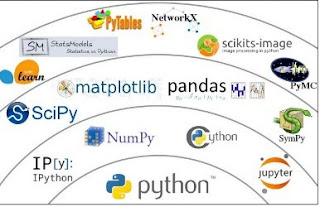As we all know Python is the favorite language for all the beginner, due to its simplicity and features.
Python has a large variety of libraries and Application.
Application of python
- Web and Internet Development
- Education
Python is a superb language for teaching programming, both at the introductory level and in more advanced courses.
- Desktop GUIs
The Tk GUI library is included with most binary distributions of Python.
Some toolkits that are usable on several platforms are available separately:
wxWidgets
- Software Development
Python is often used as a support language for software developers, for build control and management, testing, and in many other ways.
- Business Applications
Python is also used to build ERP and e-commerce systems
- Scientific and Numeric
Python is widely used in scientific and numeric computing(Basically for Analysis)
SciPy, Pandas
Top 5 Python libraries and packages for Data Scientists
- NumPy
- Pandas
- Matplotlib
- Scikit-Learn
- Scipy
NumPy
NumPy is the fundamental package for scientific computing with Python. It contains among other things:
- A powerful N-dimensional array object
- sophisticated (broadcasting) functions
- tools for integrating C/C++ and Fortran code
- useful linear algebra, Fourier transform, and random number capabilities
Click here to visit the website
Pandas
Pandas is a Python module that contains high-level data structures and tools designed for fast and easy data analysis operations
click here to visit the website
Matplotlib
Matplotlib is a Python 2D plotting library which produces publication quality figures in a variety of hardcopy formats and interactive environments across platforms. Matplotlib can be used in Python scripts, the Python and IPython shells, the Jupyter notebook, web application servers, and four graphical user interface toolkits
click here to visit the website
Scikit-Learn
Scikit-Learn is a Python module for machine learning built on top of SciPy. It provides a set of common machine learning algorithms to users through a consistent interface. Scikit-Learn helps to quickly implement popular algorithms on datasets. Have a look at the list of algorithms available in Scikit-Learn, and you will realize that it includes tools for many standard machine-learning tasks (such as clustering, classification, regression, etc.)
click here to visit the website
SciPy
SciPy is a Python module that provides convenient and fast N-dimensional array manipulation. It provides many user-friendly and efficient numerical routines, such as routines for numerical integration and optimization. SciPy has modules for optimization, linear algebra, integration and other common tasks in data science.
click here to visit the website
Buy books online:-







Comments
Post a Comment